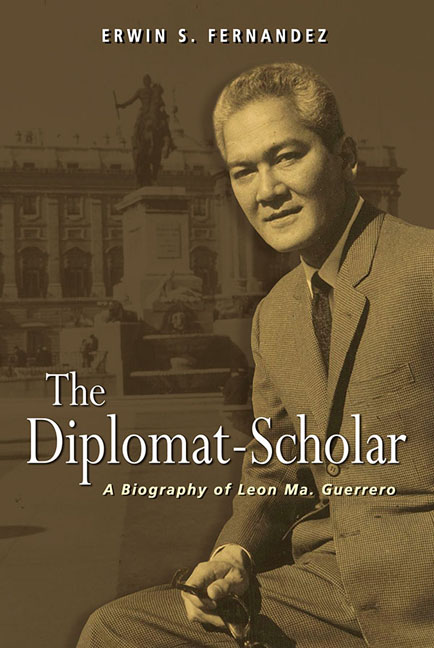Book contents
- Frontmatter
- Dedication
- Contents
- Preface
- Prologue
- Chronology
- I Ermita and Santa Cruz to Intramuros: Between Literary and Legal Career
- II To Tokyo and Back: The Making of a Diplomat
- III Going In, then Out of the Political Jungle: Padre Burgos to Arlegui
- IV London and Madrid: The Philippines in a Resurgent Asia
- V New Delhi to Belgrade: The Philippines towards Non-Alignment
- 18 Homecoming to Asia at Nehruvian India
- 19 “Diplomacy of Development” and Other Speeches
- 20 The Foreign Policy Rescuer and Again, Critic
- 21 The Diplomat as Efficient Intellectual-Bureaucrat
- 22 Endorsing Non-alignment amid Personal Crisis
- 23 Flirting with Dictators
- 24 Martial Law Propagandist
- 25 At Tito's Pre-Balkanized Yugoslavia
- Epilogue
- Glossary
- List of Abbreviations
- Bibliography
- Index
- About the Author
21 - The Diplomat as Efficient Intellectual-Bureaucrat
from V - New Delhi to Belgrade: The Philippines towards Non-Alignment
Published online by Cambridge University Press: 12 January 2018
- Frontmatter
- Dedication
- Contents
- Preface
- Prologue
- Chronology
- I Ermita and Santa Cruz to Intramuros: Between Literary and Legal Career
- II To Tokyo and Back: The Making of a Diplomat
- III Going In, then Out of the Political Jungle: Padre Burgos to Arlegui
- IV London and Madrid: The Philippines in a Resurgent Asia
- V New Delhi to Belgrade: The Philippines towards Non-Alignment
- 18 Homecoming to Asia at Nehruvian India
- 19 “Diplomacy of Development” and Other Speeches
- 20 The Foreign Policy Rescuer and Again, Critic
- 21 The Diplomat as Efficient Intellectual-Bureaucrat
- 22 Endorsing Non-alignment amid Personal Crisis
- 23 Flirting with Dictators
- 24 Martial Law Propagandist
- 25 At Tito's Pre-Balkanized Yugoslavia
- Epilogue
- Glossary
- List of Abbreviations
- Bibliography
- Index
- About the Author
Summary
Three months later in April 1969, Guerrero hit the news. A daily reported that “Guerrero would scrap annual report”. The news was based on the release of his “anti-report” by his sympathetic colleagues in the Foreign Affairs Department, which was actually written in September the previous year. Instead of submitting the usual annual report which he dutifully made his staff do in Madrid, this time in India, he was fed up with it. For his first three years in India, he submitted not an annual report but an “anti-report” because “it is a report against traditional reports … a report designed to end this type of reports”, contrary to the law requiring each embassy and consulate to annually submit 300 copies for the various offices of the government with twenty earmarked for the office of the president. How could he scrap the annual report when he was not authorized to do so? But he did — in New Delhi and perhaps even to his subsequent posts. It was a waste of money and effort costing the government which had seventy-six diplomatic missions. No one read or would read it except the employee assigned to the task or a newspaper reporter or columnist, he argued.
He did not object to the other reports required of each post such as the Post Report, monthly financial reports and quarterly inspection reports. He found it amusing that annual reports recorded the calls the chief of mission did on his colleagues and the trifling details of the visits made by various VIPs. Other contents of the report such as summaries of consular services rendered, financial statements, number of diplomatic notes, telegrams, letters and other communications sent and received, which he described as “the nadir of bureaucratic small-mindedness” as well as requests and recommendations could be taken into account in other reports sent to the Home Office.
Asked in a news conference about it, Romulo said unsmilingly: “Who says nobody reads the annual reports? I do!” Romulo in the following weeks sent Guerrero to London as the Philippine representative to the International Sugar Council's Special Hardship Relief Committee. Based on Article 44 of the council's constitution, the committee granted special concessions to the Philippines and Indonesia. All of the forty signatory countries were subjected to quota limitations but developing countries could have 60,000 tonnes each year with prior approval.
- Type
- Chapter
- Information
- The Diplomat-ScholarA Biography of Leon Ma. Guerrero, pp. 252 - 262Publisher: ISEAS–Yusof Ishak InstitutePrint publication year: 2017

